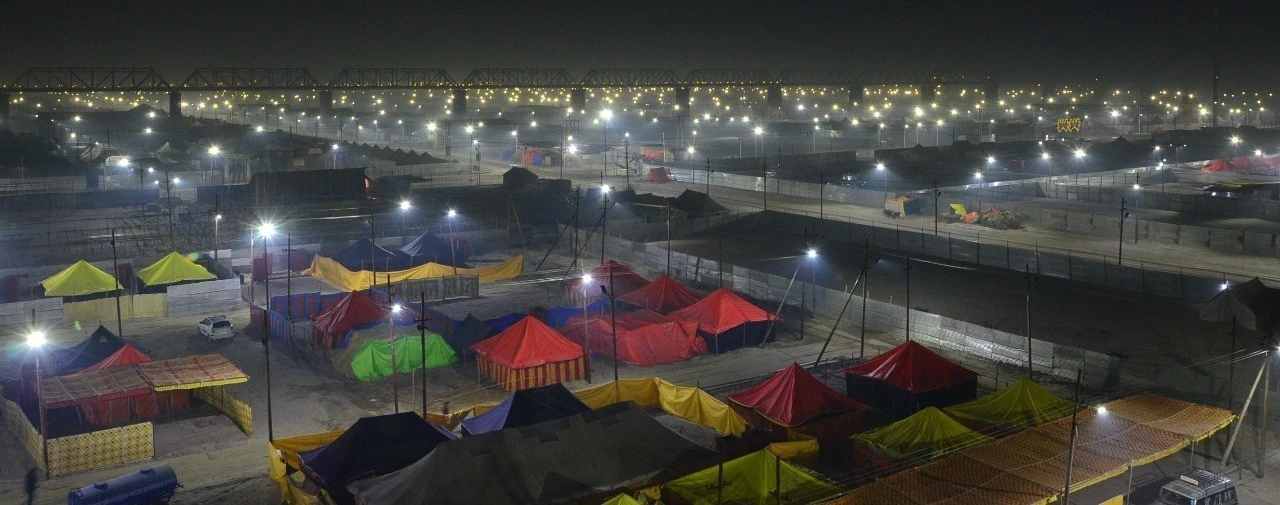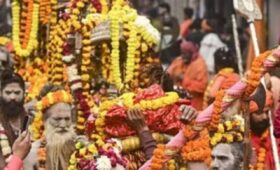The sacred confluence of the Ganga, Yamuna, and mythical Saraswati rivers in Prayagraj is known as the Triveni Sangam. Due to the distinct colors of the two visible rivers, their meeting point is clearly visible. The grand festivals of Magh Mela, Kumbh, and Maha Kumbh are held along the banks of this confluence. It is believed that bathing at the Sangam purifies one of all sins and liberates the soul from the cycle of life and death. The evening aarti performed at the Sangam holds special significance. It fills the entire atmosphere with devotion and liveliness, and the sacred sounds of the aarti resonate in every direction, making the surroundings spiritually pure.
Patalpuri Temple
This temple is located beneath the eastern gate in the underground chamber of the fort’s courtyard along the banks of the Sangam. The main entrance faces east, and a flight of stairs leads down into the temple. Inside, numerous deities and Shiva lingams are enshrined, including idols of Lord Ganesh, Baba Gorakhnath, Narasimha Avatar, Dharmaraj, and others. In total, there are 43 statues within the temple. It is renowned for its unique decoration and mystical charm. The famous Chinese traveler Hiuen Tsang visited this temple around 644 AD.
Akshay Vat
Akshayavat is currently located inside the Prayagraj Fort, near the left bank of the Yamuna River, close to the Triveni Tangam. The word ‘Akshay’ means that which is indestructible and Vat’ means banyan tree. Thus, Akshayavat translates to the indestructible banyan tree According to the ancient texts (Puranas), this tree did not perish even during the great deluge. It is believed that worshipping this revered tree grants eternal blessings
Lete/Bade Handsan Ji Temple
The Hanuman Temple is unique as it is the only temple were Lord Hanuman is seen in a reclining costure, known as “Veerbhadra formes broad forehead, large arms, and wide waist naturally inspire a sense of valor in the hearts of devotees.
Beneath the right foot of Shri Bade
Hanuman Ji’s statue is a figure of Ahiravana, symbolizing the destruction of malevolence and evil deeds, while beneath the left foot is a depiction of Kamada Devi, who is considered the goddess of willpower and was also revered by Ahiravana. Near Hanuman Ji’s statue, at the level of his forehead, are statues of Lord Ram Chandra Ji and Lakshman Ji. An interesting fact about this Hanuman Temple is that every year, during the monsoon, when the water level of the Ganga rises, the temple becomes submerged
Aadi Shri Omkar Ganpati
This reat Dashashwamedh Ghat in the This renowned pilgrimage site is Daraganj area of Prayag and is one of the 21 Siddha Ganapati pilgrimage sites in India. According to religious texts, at the beginning of the primordial era, the divine Omkar himself manifested along with the four Vedas and established the idol of Lord Ganesha here for worship. The principal days dedicated to Shri Ganesh are Chaturthi and Wednesday, with major festivals including Magh Shukla Chaturthi, Bhadra Shukla Chaturthi, and Ganeshotsav. During these festivals, thousands of pilgrims and devotees come to pay their respects and seek the blessings of Lord Ganesha.
Dwadash Madhav
According to ancient beliefs, Lord Han Vishnu took one form to protect the Sangam in agraj. These twelve temples of Lord Vishnu are located at various places in Feyagraj and are known by different names. They include Triveni Madhav (Triveni Sangam), Asi Madhav (Nagavasuki Temple), Sankatahar Madhav (Pratishthanpuri, Jhunsi), Shankh Madhav (Chatnaga, Munshi Bagh), Shri Aadi Veni Madhav (Arail), Shri Gadha Madhav (Chhinvki Village), Shri Padma Madhav (Beekar Deoria), Shri Manohar Madhav (Jansen Ganj), Shri Bindu Madhav (Draupadi Ghat), Shri Veni Madhav (Daraganj), and Shri Anant Madhav (Chaufatka).
The Veni Madhav
The temple is dedicated to Lord Vishnu in his form as Shri Veni Madhav and to Mother Lakshmi in her form as Triveni Mata. The Padma Purana states that those who bathe in the sacred waters of the Triveni Sangam and subsequently participate in the worship at the Veni Madhav Temple are liberated from the cycle of life and death. The Ramcharitmanas (Balakanda) also mentions that all sages and saints come to Prayagraj to take a holy dip in the Triveni, dwell beneath the Akshayavat, and worship Shri Veni Madhav. The renowned Vaishnav saint Chaitanya Mahaprabhu is believed to have meditated at this sacred site for an extended period. It is said that Lord Vishnu liberated the holy confluence of the Ganga, Yamuna, and Saraswati from the demon Gajakarn, promising his City dees that he would reside in Prayagraj as Shri Veni Madhav. He is regarded as the deity of Prayag.
Sanakat Mochan Mandir
The renowned Sankat Mochan Hanuman Temple, dedicated to Lord Hanuman, is located on the banks of the Ganga in the Daraganj area of Prayagraj. It is said that Saint Samarth Guru Ramdas Ji personally installed the idol of Lord Hanuman here. The temple complex also features idols of Shiva- Parvati, Ganesha, Bhairav, Durga, Kali, and the Navagraha (the nine planetary deities).
Shri Alop Shankari Temple
The Shakti Peeth of Shri Alop Shankari Devi Ji is located approximately 3 kilometers northwest of the Sangam and Akshayavat, in the Alopibagh area. According to legend, the fingers of Sati fell at this site and became lost. This is why the location is referred to as the site of Alop Shankari Devi. Here, the goddess is worshipped in the form of a small wooden swing placed atop a quadrangular pedestal with a small water tank. The merits of the visits and vows made at this place are said to be everlasting, which is another reason this site is known as Alop Shankari Temple
Shankar Viman Mandapam
Shankar Viman Mandapam is a four-story temple built in the style of South Indian architecture. This 130-foot-high temple houses statues of Kumarila Bhatta, Jagatguru Shankaracharya, Kamakshi Devi (including the 51 Shakti Peethas), and the Yogasahastra Sahasrayog Linga (surrounded by 108 Shiva Lingams)
Nagvasuki Mandir
According to the Puranas, during the churning of the ocean (Samudra Manthan) by the gods and demons, Nagraj Vasuki offered himself as the rope, coiling around Mount Mandarachal, which was used as the churning rod. The Skanda Purana refers to this place as Nagahrid Tirth on Earth, Every year, a grand fair is held here on the occasion of Nag Panchami, it is believed that after bathing in the Ganga and visiting the temple of Nag Vasuki, one’s sins are eradicated, and the Kaal Sarp Dosha is permanently nullified.
Bhishma Pitamah Temple
The Bhishma Pitamah Mandir located in Prayagraj is dedicated to Bhishma Pitamah, a central character of the Mahabharata. This is the only temple of its kind in India honoring him. Bhishma Pitamah’s original name was Devavrata, and he was the seventh son of Ganga. The temple houses a 12-foot-long statue of him, depicted lying on a bed of arrows. On the occasion of Bhishma Ashtami, a large crowd of devotees gathers at this temple, as it is believed that worshipping here grants special blessings.




